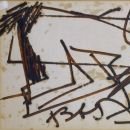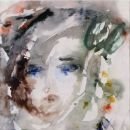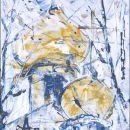Anatoly Timofeevich Zverev is one of the most striking representatives of the ‘unofficial art’ of the 1960’s. His creative journey was in many ways defiance against everyday ‘common sense’, a half-understood self-rejection of the established norms and generally accepted ideas about art. His style of painting can be seen as the link connecting the Russian avant-garde with post-modernism. The leading art historians from around the world think that Zverev’s technique combined all the schools of painting which had existed up to his time. On the other hand, George Costakis, the famous collector of icons and the Russian avant-garde, considered Zverev to be the first Russian expressionist. Moving from outdoor sketches to the worship of the clean stroke, he developed in the second half of the 1950’s an original, temperamental, even ‘turbulent’ style of painting which can be best called ‘figurative tachism’ or a ‘figurative-non-objective’ style since the landscape, still-life and portrait motifs here are radically transformed into a natural play of colours, more or less retaining its character, its objective ‘recognisability’. Especially typical of his art are the lyrical-impulsive portraits of women. Working normally in watercolours, oil or pencil, he would readily improvise and what is more, the very act of improvisation would itself turn into an act of art, an original ‘happening’ which would end with a bold signature stroke. The culmination, the personal peak of Zverev’s creativity was at the end of the 1950’s and the start of the 1960’s was a kind of living evocation of the spirit of the then free ‘independent-underground’ trends in art.
THE TSUKANOV ART COLLECTION



 |
Zverev Anatoly | ‘Today’s artist, even if he has not a single paint, should be able to draw using a lump of earth or clay’. |
1931 - 1986 | ||
‘Over the course of many periods of his work, Anatoly Zverev used a tricolour technique — taking a white sheet of paper and three colours, he would create romantic still-lifes, portraits and would paint tree trunks … He recorded everything around him. Zverev really painted a lot, wherever he could… His well-known trips to the zoo with his endless notebooks where he would draw snakes and birds were probably the peak of his creativity …’. George Costakis
‘Each stroke of his brush was a treasure. Artists of his stature come by just once a century’. Robert Faulk
‘Each stroke of his brush was a treasure. Artists of his stature come by just once a century’. Robert Faulk
The artist's work can be found in the following museums and collections:
| Portrait of Dmitry Plavinsky Museum «Drugoe Iskusstvo» | Portrait Kolodzei Art Foundation | Don Quixote Contemporary Art Museum |





